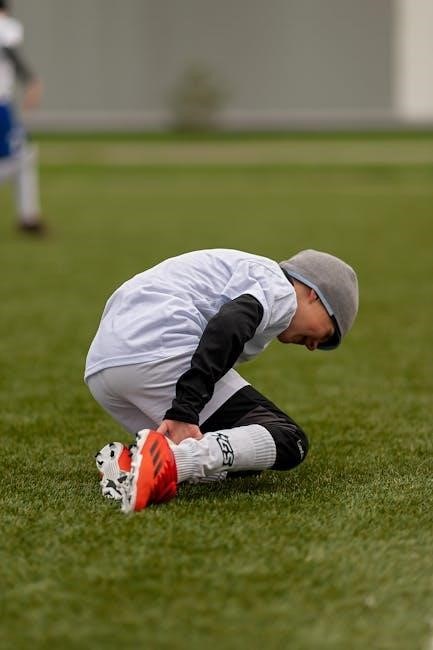A structured approach to hamstring injury exercises is crucial for recovery and prevention of re-injury. These exercises focus on stretching, strengthening, and dynamic movements to restore function and mobility.
Overview of Hamstring Injuries
Hamstring injuries are common among athletes and individuals engaging in physical activities. They occur when one or more of the hamstring muscles—biceps femoris, semitendinosus, or semimembranosus—suffer a strain or tear. These injuries range from mild muscle pulls to complete ruptures, often causing pain, swelling, and limited mobility. Acute hamstring injuries typically result from sudden sprinting, jumping, or abrupt stops, while chronic conditions may develop from repetitive stress or poor muscle flexibility. Symptoms include sharp pain during activities like knee flexion, bruising, and inflammation. If left untreated, these injuries can lead to prolonged recovery, tendon stiffness, and increased risk of re-injury. Understanding the severity and type of injury is crucial for effective treatment and rehabilitation.
Importance of Rehabilitation Exercises
Rehabilitation exercises play a vital role in restoring strength, flexibility, and function after a hamstring injury. A well-structured program helps prevent re-injury, reduces chronic pain, and accelerates return to normal activities or sports. Early mobilization and controlled movements promote healing, while progressive strengthening and eccentric exercises address muscle imbalances. Proper rehabilitation also enhances blood flow, reduces scar tissue formation, and improves joint stability. Consistency in performing these exercises ensures optimal recovery and minimizes the risk of long-term complications. By focusing on pain-free movements and gradual progression, individuals can achieve full functional recovery and maintain peak physical performance.

Understanding Hamstring Anatomy and Injury Types
The hamstrings comprise three muscles crucial for knee flexion and hip extension. Injuries range from mild strains to severe tears, significantly affecting mobility and stability.
Hamstring Muscle Structure
The hamstrings consist of three muscles: the biceps femoris, semitendinosus, and semimembranosus. These muscles originate from the ischial tuberosity and insert into the tibia and fibula. They play a key role in knee flexion and hip extension. The hamstrings also include tendons that connect muscles to bones, facilitating movement. Injuries often occur at the muscle-tendon junction due to excessive strain or sudden contraction. Weakness or imbalances in these muscles can lead to poor movement patterns, increasing injury risk. Understanding the structure helps in designing targeted exercises for rehabilitation, focusing on strengthening and stretching to restore proper function and prevent re-injury.
Common Causes of Hamstring Injuries
Hamstring injuries often result from muscle imbalances, insufficient warm-ups, or overstretching. Activities involving sudden sprints, jumps, or sharp changes in direction increase the risk. Weakness in the hamstrings or hip muscles can lead to poor movement patterns, straining the muscles. Overtraining or repetitive stress without adequate recovery also contributes to injuries. Tight hamstrings or prior injuries may predispose individuals to re-injury. Understanding these causes is essential for developing prevention strategies, such as targeted stretching, strengthening, and proper warm-up routines. Addressing muscle imbalances and improving flexibility can significantly reduce the likelihood of hamstring strains during physical activity or sports.

Phase 1: Acute Phase Rehabilitation
Phase 1 focuses on pain management, rest, and initial stretching exercises to promote healing and prevent further injury during the acute phase. This phase is crucial for setting the foundation of recovery.
Pain Management and Rest
Effective pain management and rest are critical during the acute phase of hamstring injury rehabilitation. Immediately after injury, applying the RICE method—Rest, Ice, Compression, and Elevation—helps reduce pain and inflammation. Nonsteroidal anti-inflammatory drugs (NSAIDs) may be recommended to alleviate discomfort. It is essential to avoid activities that exacerbate the injury to prevent further damage. A period of relative rest ensures the hamstring muscles and tendons begin the healing process without interruption. Pain should be managed within a tolerable range, and exercises should be modified to avoid exacerbating the injury. Proper rest and pain management lay the foundation for successful rehabilitation and prevent complications.
Initial Stretching Exercises
Initial stretching exercises are gentle and essential to improve flexibility and reduce muscle tension after a hamstring injury. Standing hamstring stretches are often recommended, where the injured leg is placed on a stool with the knee straight, and the individual leans forward slightly. Seated stretches, such as reaching toward the toes, can also be effective. These exercises should be performed pain-free, with a focus on controlled movements to avoid further strain. Stretching helps restore normal muscle length and promotes blood flow to the injured area. Consistency is key, as regular stretching accelerates recovery and prepares the hamstrings for more intense rehabilitation phases. Always ensure stretches are held for 20-30 seconds to maximize effectiveness.
Phase 2: Subacute Phase Strengthening
This phase focuses on progressive strengthening exercises to rebuild hamstring muscle strength and endurance. Eccentric loading and resistance exercises are emphasized to enhance muscle repair and functionality.

Progressive Strengthening Exercises
Progressive strengthening exercises are essential during the subacute phase to restore hamstring function. These exercises gradually increase resistance, often using resistance bands or weights, to enhance muscle endurance and power. Techniques include bridges, Swiss ball curls, and step-ups, which target the hamstrings while minimizing stress on the injured area. Isometric exercises, such as wall sits or hamstring holds, are often introduced early to build strength without movement. As progress is made, dynamic exercises like leg curls and deadlifts are incorporated to improve functional strength. Eccentric exercises, focusing on the lengthening phase of muscle contractions, are particularly effective for repairing damaged tissues and reducing re-injury risk. These exercises must be performed pain-free to ensure proper healing and progression.
Eccentric Loading Techniques
Eccentric loading techniques focus on the lengthening phase of muscle contractions, which is critical for repairing and strengthening the hamstrings. These exercises, such as Nordic hamstring curls and heel slides, emphasize controlled movements that target the hamstrings’ ability to absorb force. Eccentric training helps break the cycle of pain, atrophy, and re-injury by improving tendon stiffness and muscle resilience. Patients are instructed to perform these exercises slowly and within a pain-free range, ensuring proper tissue repair. Over time, eccentric loading enhances muscle strength and endurance, reducing the risk of future hamstring strains. This approach is particularly effective when combined with progressive strengthening and dynamic movements, making it a cornerstone of hamstring rehabilitation programs.

Phase 3: Dynamic and Sports-Specific Training
This phase transitions into dynamic movements and sport-specific drills, focusing on agility, balance, and functional exercises tailored to the athlete’s sport. It aims to restore peak performance safely;
Agility Drills and Balance Exercises
Agility drills and balance exercises are crucial in the final stages of hamstring rehabilitation. These activities, such as cone drills, ladder exercises, and single-leg stability work, enhance neuromuscular coordination and reestablish sport-specific movements. Balance exercises, including wobble board training and BOSU ball workouts, improve proprioception and reduce the risk of re-injury. Progressing to multi-directional movements mimics real-world athletic scenarios, ensuring the hamstring muscles are prepared for dynamic stresses. These drills are tailored to the individual’s progress and sport requirements, fostering confidence and readiness for full activity. Proper execution and gradual intensity increase are key to maximizing benefits and ensuring a safe return to play.
Functional Movements for Sports Readiness
Functional movements are designed to mimic real-world athletic activities, ensuring a smooth transition back to sports. These exercises focus on dynamic, multi-planar motions that replicate game-like scenarios, such as sprinting, cutting, and changing direction. Examples include step-ups, lateral lunges, and shuttle runs, which target the hamstrings while engaging other lower limb muscles. Multifaceted drills that combine strength, agility, and coordination are emphasized to enhance sport-specific performance. Proper form and gradual progression are critical to avoid overload and ensure readiness. These movements bridge the gap between controlled rehabilitation and unrestricted athletic participation, helping athletes regain confidence and functionality in their sport of choice.
Prevention of Hamstring Re-Injury
Preventing hamstring re-injury involves consistent stretching, strengthening, and proper warm-up routines. Incorporating eccentric exercises and monitoring muscle tightness can significantly reduce the risk of recurrence and enhance durability.
Long-Term Stretching and Strengthening
Long-term stretching and strengthening are essential for maintaining hamstring health and preventing re-injury. Consistent stretching exercises, such as standing hamstring stretches and seated stretches, improve flexibility and reduce muscle tightness. Strengthening routines, including eccentric exercises, focus on building endurance and power in the hamstrings. These exercises should be performed progressively, increasing intensity and resistance over time. Incorporating activities like cycling or swimming can also enhance muscle endurance without overloading the hamstrings. Regularly incorporating these exercises into a fitness routine ensures sustained strength and flexibility, reducing the likelihood of future injuries and promoting overall lower limb stability. Consistency is key to achieving long-term benefits and maintaining optimal hamstring function.
Proper Warm-Up and Cool-Down Routines
A proper warm-up and cool-down are critical for preventing hamstring injuries and aiding recovery. Begin with light cardio such as jogging or cycling to increase blood flow. Incorporate dynamic stretches like leg swings and high knees to activate the hamstrings. Post-exercise, focus on static stretches to improve flexibility and reduce muscle tension. Include muscle activation exercises to ensure proper hamstring engagement. A structured warm-up and cool-down routine enhances performance, accelerates recovery, and minimizes the risk of injury prevention. Consistency in these routines is vital for long-term hamstring health and functional stability. Always ensure exercises are pain-free and avoid movements that cause discomfort or strain.